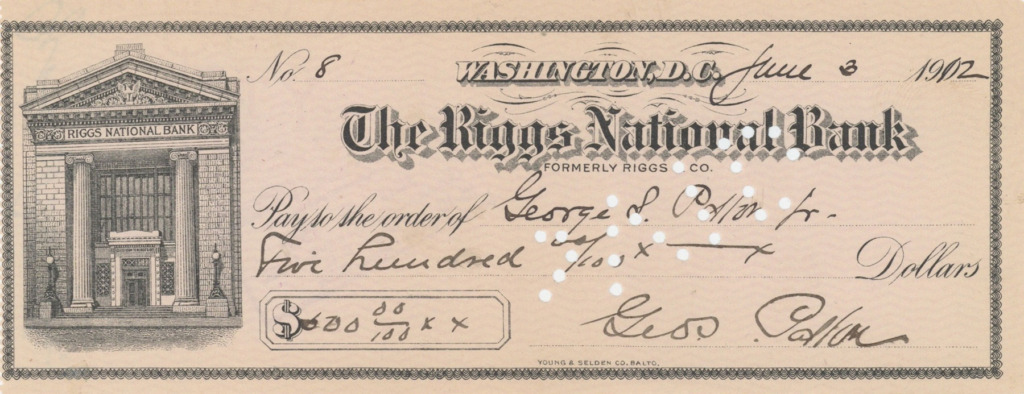Twenty-Six-Year-Old George S. Patton, Jr. Sets Off to Compete in the First Ever Modern Pentathlon as the US Representative




The checks written, one signed by Patton, Jr. himself, to pay for his voyage to Europe and his support while competing
- Currency:
- USD
- GBP
- JPY
- EUR
- CNY
Patton would compete on the same team as Jim Thorpe
Gen. George Smith Patton Jr. was one of the most brilliant soldiers in American history. Audacious, unorthodox and inspiring, he led his troops to great victories in North Africa, Sicily and on the European Western Front after the landings on D-Day. At...
Patton would compete on the same team as Jim Thorpe
Gen. George Smith Patton Jr. was one of the most brilliant soldiers in American history. Audacious, unorthodox and inspiring, he led his troops to great victories in North Africa, Sicily and on the European Western Front after the landings on D-Day. At El Guettar in March of 1943 he won the first major American victory over Nazi arms. In July of that year he leaped from a landing barge and waded ashore to the beachhead at Gela, Sicily. In just thirty-eight days the American Seventh Army, under his leadership, and the British Eighth Army, under Gen. Sir Bernard Montgomery, conquered all of Sicily.
He was the leader of his famed Third Army on the Western Front that Patton staked out his strongest claims to military greatness. In ten months his armor and infantry roared through six countries – France, Belgium, Luxembourg, Germany, Czechoslovakia and Austria. It crossed the Seine, the Loire, the Moselle, the Saar, the Rhine, the Danube and a score of lesser rivers; captured more than 750,000 Nazis, and killed or disabled 500,000 others. It was instrumental in winning the crucial battle of the Bulge in December 1944. There were times, in those great days when the tank spearheads of the Third were racing across France with almost unbelievable speed and again when they were cutting the dying Nazi armies to pieces in the final spring of the war, that not even Supreme Headquarters itself knew where his vanguards were. Driven by his iron will, his advanced units had to be supplied with gasoline and maps dropped by air. By the time Germany surrendered on V-E Day – May 8, 1945 – Patton’s Third Army had fought for nine months since becoming operational, capturing more than 80,000 square miles of territory. During that time the Third Army suffered roughly 137,000 casualties, but it had inflicted more than 10 times that on the enemy.
Patton was born in 1885 and in May of 1912, he was 26 years. After attending school in Pasadena, Patton enrolled at the Virginia Military Institute. From there he went to the United States Military Academy at West Point. He graduated from West Point in 1909, and was commissioned as a second lieutenant. After graduation from the USMA, Patton served in the cavalry in Fort Sheridan, Illinois until December 1911. He was then transferred to Fort Myer, Virginia.
Patton, through his training and prior upbringing, was skilled at the events that comprised the pentathlon. Patton was selected for the 1912 U.S. Olympic team for the first ever Olympic modern pentathlon event, held in Stockholm, Sweden. The new event was created to test military men in five sports challenges: fencing, swimming, shooting, equestrian jumping and running. Patton finished a respectable fifth place overall. So in the late Spring/early Summer of 1912, he set about heading to Europe, with the financial support of his father, setting sail in June 1912.
Document Signed, Washington DC, May 27, 1912, on Riggs National Bank check stock, being a check for $550 made out to the Atlantic Transport Line for his son’s travel to compete in the Olympic Games.
Document signed, by George S. Patton Sr. and Jr., Washington DC, June 3, 1912, on Riggs National Bank check stock, being a check for $500 made out to Patton Jr. Signed by Patton Sr. on the front and endorsed by Patton Jr. on the verso.
Patton would go on to compete but not to medal. Controversy developed when Patton insisted, that in shooting, one of his bullets had gone through a previously made hole and that he had achieved yet another bulls eye. The judges contended that the absence of another hole indicated a shot had missed the mark entirely. Patton insisted through the rest of his life he had been robbed of his duly earned medal.

Frame, Display, Preserve
Each frame is custom constructed, using only proper museum archival materials. This includes:The finest frames, tailored to match the document you have chosen. These can period style, antiqued, gilded, wood, etc. Fabric mats, including silk and satin, as well as museum mat board with hand painted bevels. Attachment of the document to the matting to ensure its protection. This "hinging" is done according to archival standards. Protective "glass," or Tru Vue Optium Acrylic glazing, which is shatter resistant, 99% UV protective, and anti-reflective. You benefit from our decades of experience in designing and creating beautiful, compelling, and protective framed historical documents.
Learn more about our Framing Services












































































































